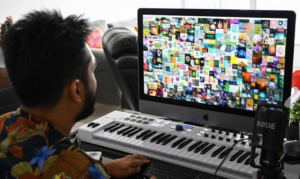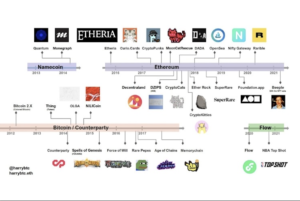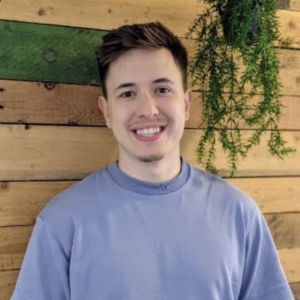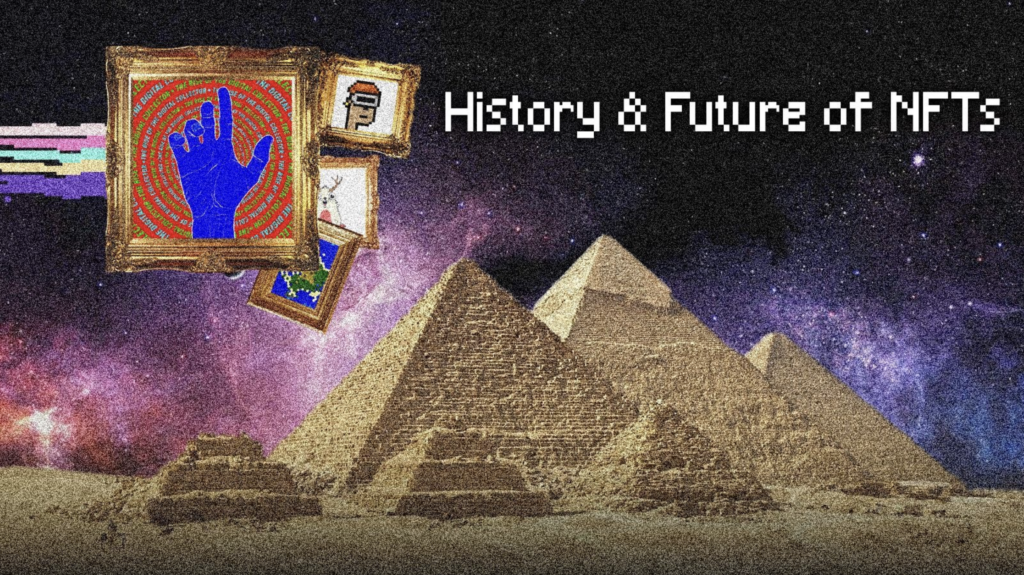Producing this podcast has been a truly amazing, educational experience for me.
To be able to edit and interview some amazing people in the space is something that very few have the privilege to do.
My favourite quote from the documentary is;
“I always wondered what it’d be like to be there when the pyramids are built. Now, I know what that’s like with the metaverse.”
I’m paraphrasing – but being able to document such an amazing period in the digital world has been amazing. This is a blank canvas that we’re all drawing on.
NFTs ‘clicked’ for me when I thought about three different things:
- Owning things digitally only feels weird to people because we’ve been humans in the physical world for 30,000 years, but the internet was only born 30 years ago. 1/10,000th of our existence has been exposed to something virtual
- The internet we built did a great job of making information available. But it also locked up a lot of value in centralized places. NFTs unfreeze digital assets and integrate value and ownership
- NFTs are just better. Immutable, permissionless, transportable, they give you provenance, they can’t be scratched or torn.
When creating this piece of work – which I think is one of the best and most immersive pieces of audio content to be made surrounding NFTs – I had to take inspiration from a variety of places.
As with NFTs themselves, the vibe was important.
Let’s start off with the process & structure:
We had recorded 40-50 interviews with some of the greatest pioneers in the history of NFTs, all 20 minutes each. I listened to all of these, transcribed them, and picked out the bits of magic that I felt really perked my ears when I listened to them. I then created a 20-30-page-long document with quotes from all of these interviewees that I thought were worthy of being in the documentary.
The structure was then decided upon. We wanted this to be a three-part series that looked at the past, present, and future of NFTs. They were titled:
- Act 1: The History of NFTs
- Act 2: The Rise of the digital collector
- Act 3: The Future of NFTs
Then it was time to write a narrative.
This was the most time-consuming part of the documentary. Writing is difficult in and of itself, but writing for someone to say the thing you’re writing is even more challenging. This is why I actually spoke everything I was writing into a microphone. I then began to create an audio wireframe of sorts for the documentary, which made this piece of work what it is. This was fundamental in creating something that not only read and spoke well – but felt right.
A skeleton of speech that I’d then write out and iterate, change and warp to ensure the vibe and feel of the documentary was aligned to the very culture we’re seeing being created with NFTs.
Moulding this skeleton around critical themes and adding quotes from interviewees were the next two steps.
This is where the documentary really started to take shape. The diversity of voices began to breathe life into the audio. It quickly became a lot more immersive and powerful than I had first imagined. The messaging, the sounds, the voices and the general vibe all started to knit together nicely. After there was a solid framework of audio, it was time for my esteemed host to read it all out in a professional studio.
And up next, it was time to replace all my audio with Jamie’s.
We then had something close to the final thing but needed a few finishing touches. Unfortunately, this ended up dragging Jamie back in the recording booth a couple more times than anticipated – but I think it was worth it. And there you have it – an audio documentary on the History and Future of NFTs.

Inspiration & influence
I’m not a creative genius, so obviously, there was a lot of influence in this piece of work!
-
- Cassettes opening and closing
One of the things that is heard throughout this documentary is the cassette box opening sound and the stopping of the cassette sound.
These indicate the start and stop of a quote/mash-up of quotes from an interviewee. I chose this because NFTs are networked nostalgia, and I knew that there would be an instant connection for people in their 30s with that sound. I’m 25, so I can’t proclaim to be someone who used cassettes for music a lot, but I still recognize the tangible feeling of pressing that cassette into a player and hearing something you love, play. This sound was actually inspired by a song I love called 2055 by an artist called Sleepy Hallow. The rapper explains the meaning behind the song:
“It’s like getting away from everything, whatever problems you got, stress, [you] feel me? Just being in that zone in your own moment, you in 2055, you in the future, you doin’ whatever you want.”
To me, when creating this documentary – I really did feel like I was in my own world. I’d forget about everything else that was going on and immerse myself in hours of perfecting the content. A lot of you will know that feeling when you’re in the ‘zone’ when working – but this didn’t feel like work. It felt like an exploration and how I imagine artists feel when locking in to create a piece of art. At that point, that’s what I started to view this as– a piece of art that would live in NFT culture (hopefully) forever. I also feel this quote by Sleepy Hallow is reflects a big reason why NFTs have become so big. During Covid, people became digitally native. We started ‘being’ online more than we did in person. I think the mental fatigue of what we went through as humans during the pandemic will be looked at as the start of a digital revolution.
- Cassettes opening and closing
- Asides – inspired by the big short
I was very conscious of the fact that this new world is complex. I’m blessed to have worked in Crypto, or adjacent to it, since 2017 on the media side. So I’m well versed in the vernacular, and I’m fortunate to have had this many years in the ‘industry.’ But many have not and want to learn.
We had to break down the barrier to entry from a knowledge standpoint if this podcast was to stand the test of time and gain mainstream attention. Every time you hear a rewind type of noise in the audio documentary, it signals the commencement of an explanation.
This was inspired by The Big Short, the amazing film that had asides within it – sometimes by celebrities – to explain complex financial jargon in an entertaining and accessible way. Now we didn’t have Selena Gomez doing this, but I think Jamie did an admirable job explaining complex topics in a simplified manner.
- Music
The music chosen throughout the documentary was inspired by several different things. Below is a brief background on two prime sources of inspiration.
- Westworld: If you don’t know what Westworld is, it’s a dystopian sci-fi series based in a theme park called Westworld, where androids roam, and humans visit to do whatever they like. A lot of the music is a little bit cowboy/western in its nature to have inspired the documentary. Still, some of the piano/SciFi-type melodies did inspire some of the background music used in this documentary.
- Interstellar: Cliche, but the scoring in this film is fantastic, and a lot of the ambient music used is similar to what we used to break up bits of the documentary. The organ-based scoring makes for a ‘natural’ feel and one that allures the listener.

Final thoughts
There we have it; “How to make an audio documentary.”
It was incredibly fun, and I’ll be replicating this format and way of creating audio content a lot in the future. The Crypto space is littered with amazing content, but I think it moves too quickly for content to keep up.
That’s why sometimes, like with this documentary – slowing down and taking everything that’s happened in can sometimes lead to something awesome.
Hopefully, listeners feel the same.



